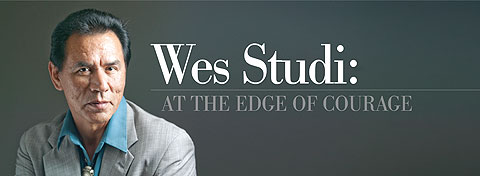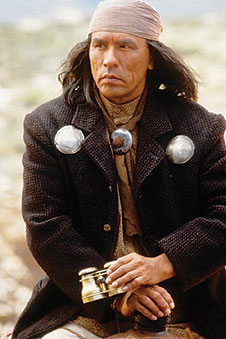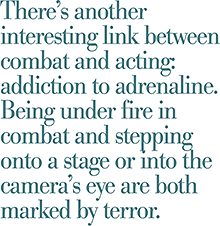 |
||||||||||||
|
March/April 2015
BY RICHARD CURREY The celebrated American Indian actor Wes Studi recalls that while growing up on the Cherokee Nation in Oklahoma, expectations for him or any other young Indian never ran high. A teacher advised his Indian students, Studi among them, to harbor no false expectations about what they might achieve in life, and to expect work as laborers or farm hands. The fact that Wes Studi would became a renowned film and television actor was inconceivable—to both Studi and his teachers. So much so that while attending an Indian boarding school at age 17, Studi struck out on a very different path: He joined the National Guard. “I was underage so I got my parents’ permission to join,” he said. “I went through basic and on to Ft. Polk for AIT.” Shortly thereafter he was placed on active reserve status, posted to Ft. Benning, and met soldiers returning from Vietnam. “They had stories! Funny stories. Horrible stories. Sad stories. I started wondering about the Vietnam experience—what it was about, how I’d fare if I were there, how I’d react. And I decided to volunteer.” Studi was assigned to Alpha Co., 3/39th Infantry. He saw service in urban warfare in the Cholon section of Saigon, in the bush, and with Navy riverine operations.
Studi went to college, first in Tulsa and later at Northeastern State University in Talequah, the capital of the Cherokee Nation. He gravitated toward the student unrest of the time. “The counterculture, war resistance, women’s rights, Indian rights. It was all happening and colleges were the flash points.” Studi became involved with the American Indian Movement and was part of the AIM takeover of the Bureau of Indian Affairs building in Washington, D.C. But as the impact of the counterculture began to lose energy in the early seventies, Studi refocused on college. “A vet needed a minimum number of credit hours to qualify for GI Bill benefits,” he said. “To fill out one of my semesters I chose an elective, stagecraft. And I really enjoyed it. “I had some friends in Tulsa who’d formed a theatre company. They asked if I would be interested in doing some acting workshops, and I did.” Studi recalls performing “anywhere and everywhere we could. We rarely got paid. I remember once getting $12 for a show and it felt like a big deal.” When he was spotted by a Nebraska public television producer in a staging of the book Black Elk Speaks, Studi landed work in a docudrama about American Indians. “I started thinking that it might be time to see if I could get work in feature films.” Studi stayed with a friend in Los Angeles and made the rounds of agents. It was tough to get traction, but Studi found an agent willing to represent him. He was cast in Powwow Highway in 1989, one of the first movies to take an honest look at the lives of contemporary Indians. The next year he landed a part in the Kevin Costner film Dances with Wolves. But it was 1992’s Last of the Mohicans that was Studi’s breakout role. Studi played Magua, a Huron Indian with an abiding hatred for the British who murdered his family, bringing a depth and resonance to the role unseen in the many previous film versions. Critics praised Studi’s work, and since Mohicans he has appeared in many films and television shows across a 30-year career. It was acting that would ultimately come to be his spiritual and creative home—a Vietnam veteran for whom acting was deeply therapeutic. Might it be so for a younger generation of vets?
“I didn’t know it at the time, but I substituted the adrenaline rush of battle with what was chemically the same experience, except it was derived from acting. Acting is something done out at the edge of one’s courage and resolve. And that sparks the adrenaline.” Studi believes this is why acting has been a deeply therapeutic activity for him as a veteran. “I found the same intensity of experience, but in a productive fashion. It helped me phase back into postwar life. And that might be true for others.” For Studi, “there is no reorientation into peace. War may be hell but peace can be a killer, too. It is absolutely incumbent on the nation to take care of our veterans. Interventions—be it counseling or acting or farming or anything else—need to get out ahead of the pain and tragedies. This cannot be said enough. Our veterans’ lives depend on it.”
|
||||||||||||
|
|
||||||||||||
|
||||||||||||
8719 Colesville Road, Suite 100, Silver Spring. MD 20910 | www.vva.org | contact us |
||||||||||||













 When his tour ended on the same day as his discharge date, Studi found himself back home in Oklahoma with “no idea what the hell to do. I didn’t want to do anything. So I traveled around the country, visited some Army buddies. It was a confusing time.”
When his tour ended on the same day as his discharge date, Studi found himself back home in Oklahoma with “no idea what the hell to do. I didn’t want to do anything. So I traveled around the country, visited some Army buddies. It was a confusing time.” “I think it certainly could be,” Studi says. “But not only as a form of self-expression. There’s another interesting link between combat and acting: addiction to adrenaline.” Studi says that being under fire in combat and stepping onto a stage or into the camera’s eye in a movie are both marked by terror. “Obviously the physical danger is not the same, but your body doesn’t know that. Your brain only recognizes fear. The adrenaline that floods your bloodstream is the same no matter what stimulates it.
“I think it certainly could be,” Studi says. “But not only as a form of self-expression. There’s another interesting link between combat and acting: addiction to adrenaline.” Studi says that being under fire in combat and stepping onto a stage or into the camera’s eye in a movie are both marked by terror. “Obviously the physical danger is not the same, but your body doesn’t know that. Your brain only recognizes fear. The adrenaline that floods your bloodstream is the same no matter what stimulates it.